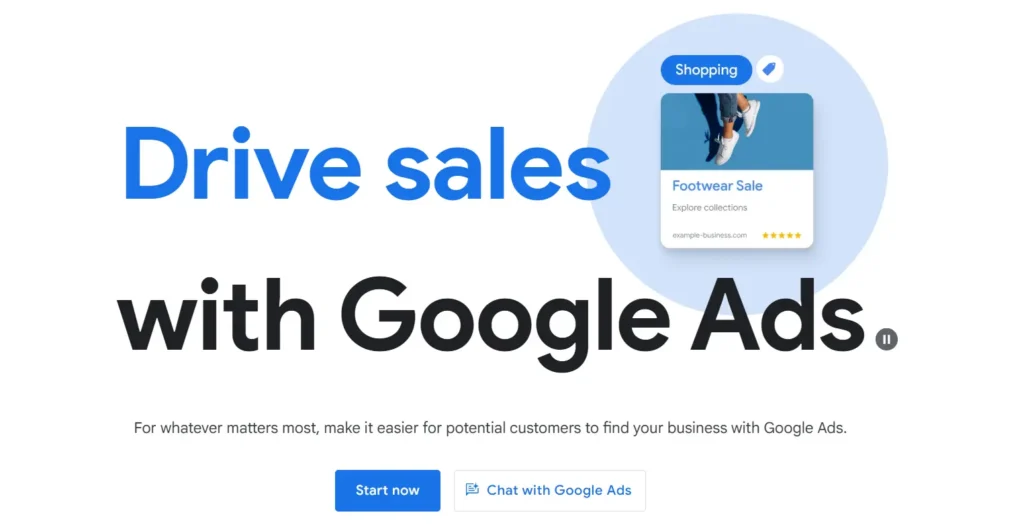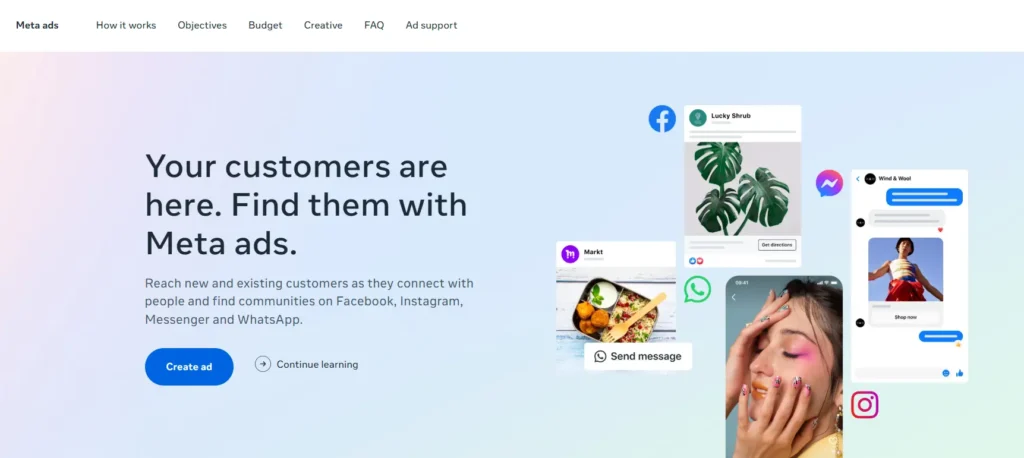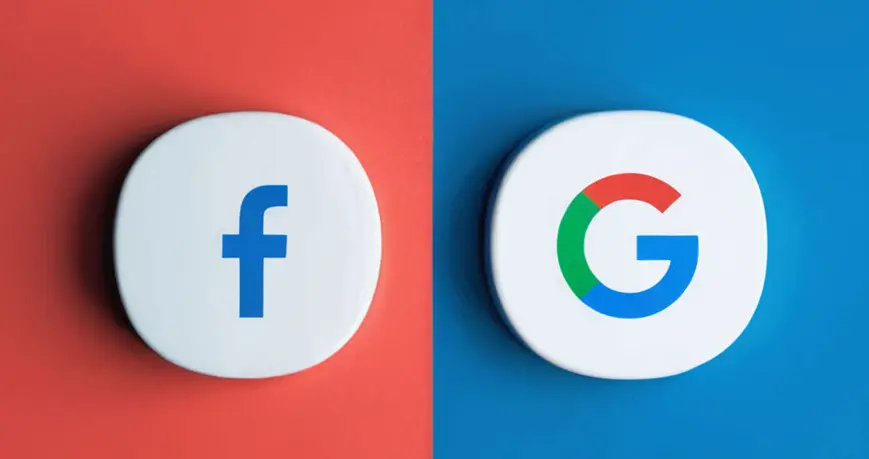When it comes to digital advertising, two platforms dominate the industry—Google Ads and Facebook Ads. While both offer powerful ways to reach potential customers, they work differently and serve different marketing purposes.
Google Ads is intent-based advertising, meaning users actively search for a product or service before seeing an ad.
Facebook Ads, on the other hand, is interest-based advertising, where ads are shown based on a user’s demographics, behaviors, and interests.
So, which one should you use for your business? Let’s break down the key differences between Google Ads and Facebook Ads so you can make the right decision!
Differences Between Google Ads and Facebook Ads

While both platforms allow businesses to promote products and services, they function in completely different ways.
Below are the main differences between Google Ads and Facebook Ads:
1. Ad Targeting: Intent vs. Interest-Based Advertising
- Google Ads: Targets users based on keywords they type into Google Search.
- Example: If someone searches for “best running shoes for beginners,” Google shows ads from sports brands selling running shoes.
- Facebook Ads: Targets users based on demographics, behaviors, and interests.
- Example: If someone follows fitness influencers, they might see ads for running shoes even if they never searched for them.
Key Takeaway: Google Ads captures existing demand, while Facebook Ads creates new demand by targeting users who may not be actively searching for a product.
2. Ad Placement & Where Ads Appear
- Google Ads: Ads appear in Google Search results, YouTube, Google Display Network, Google Shopping, and Gmail.
- Facebook Ads: Ads appear in Facebook Feeds, Instagram, Messenger, Audience Network, and Stories.
Key Takeaway: Google Ads gives businesses access to search-driven traffic, while Facebook Ads provides access to social media audiences across Meta platforms.
3. Ad Formats & Creativity
- Google Ads: Primarily text-based for Search Ads, but also offers Shopping Ads, Display Ads, and Video Ads.
- Facebook Ads: Heavily visual, including image ads, video ads, carousel ads, and Stories ads.
Key Takeaway: Facebook Ads are more creative and visually engaging, while Google Ads rely more on text-based relevance.
4. Cost & Budgeting
- Google Ads cost varies based on competition for keywords. Industries like legal, finance, and real estate have higher CPCs (cost per click).
- Facebook Ads generally have lower CPCs than Google but require ongoing testing to optimize audience targeting.
Key Takeaway: If you have a tight budget, Facebook Ads may be more cost-effective, but Google Ads provide higher intent-based conversions.
5. Performance Metrics & Tracking
- Google Ads tracks conversions through search impressions, CTR (click-through rate), and cost-per-conversion.
- Facebook Ads tracks performance based on engagement, reach, video views, and conversions.
Key Takeaway: Google Ads is better for direct-response campaigns, while Facebook Ads is great for brand awareness and audience engagement.
Pros and Cons of Google Ads

Google Ads is one of the most effective advertising platforms for businesses looking to generate high-intent leads and sales.
However, like any marketing tool, it has its advantages and disadvantages. Below, we’ll explore the pros and cons of using Google Ads so you can determine whether it’s the right fit for your business.
Pros of Using Google Ads
1. Immediate Visibility on Google’s Search Results
Unlike SEO, which takes months to build organic traffic, Google Ads allows businesses to appear at the top of search results instantly.
If you’re in a highly competitive industry, this visibility is crucial for gaining leads and conversions quickly.
Best For: Businesses that need fast results, such as limited-time promotions, product launches, or event registrations.
2. High-Intent Audience with Better Conversion Rates
Google Ads connects businesses with users who are actively searching for a product or service. Since these users already have intent, they are more likely to convert.
Best For: Businesses that sell high-ticket services or products, such as law firms, SaaS companies, real estate agencies, and medical practices.
3. Advanced Bidding & Budget Control
Google Ads offers flexible bidding strategies, allowing businesses to set a daily budget, bid caps, and automated bid adjustments. This means you have full control over your ad spend.
Best For: Businesses that want precise budget management, such as startups, small businesses, and companies with specific ROI goals.
4. Multiple Ad Formats for Different Goals
Google Ads isn’t just about text-based Search Ads—it also includes Shopping Ads, Display Ads, YouTube Ads, and Performance Max campaigns, making it a versatile advertising tool.
Best For: Businesses that need different ad formats, such as:
- eCommerce brands (Shopping Ads)
- Retail & local businesses (Local Ads)
- Tech & B2B brands (Search & Display Ads)
5. Integration with Google Analytics & Other Tools
Google Ads seamlessly integrates with Google Analytics, Google Tag Manager, and CRM platforms, allowing businesses to track user behavior, conversions, and return on ad spend (ROAS) in detail.
Best For: Businesses that rely on data-driven marketing decisions and want to measure performance across multiple channels.
Cons of Using Google Ads
1. High Competition in Certain Industries
Because Google Ads works on an auction-based model, industries like legal, insurance, finance, and SaaS often experience high CPC (cost-per-click) due to intense competition.
- Challenge: Businesses in highly competitive industries may find Google Ads too expensive if they don’t have an optimized strategy.
- Solution: Use long-tail keywords, location targeting, and negative keywords to reduce ad costs.
2. Requires Expertise to Get the Best Results
Unlike Facebook Ads, which are more intuitive, Google Ads has a steep learning curve, especially with features like:
- Bid strategies (Manual vs. Smart Bidding)
- Ad extensions & audience segmentation
- Quality Score optimization
Challenge: Beginners may waste budget on ineffective campaigns
Solution: Work with our Google Ads specialists from Sydney to manage and optimize campaigns!
3. Click Fraud & Bot Traffic Risks
Google Ads is susceptible to click fraud, where competitors or bots artificially click on ads to deplete ad budgets. While Google has fraud detection measures, it still happens.
Challenge: Businesses may lose money on invalid clicks.
Solution: Use Google Ads’ automatic fraud detection, implement IP exclusions, and monitor suspicious click patterns.
4. ROI Takes Time (Not Always Instant)
While Google Ads provides immediate visibility, optimizing campaigns for maximum ROI can take weeks or months.
Challenge: Businesses expecting quick wins may be disappointed if they don’t refine their campaigns over time.
Solution: Start with a test budget, analyze click-through rate (CTR) and optimize based on performance.
5. Keyword Costs Can Vary Wildly
Unlike Facebook Ads, which are more budget-friendly, Google Ads relies on keyword bidding, meaning CPC can fluctuate significantly based on:
- Time of day
- Seasonality
- Competitor activity
Challenge: Ad costs may spike unexpectedly during peak times.
Solution: Use automated bid adjustments to optimize ad spend efficiently.
Pros and Cons of Facebook Ads

Facebook Ads is a powerful advertising platform that allows businesses to target specific audiences based on demographics, interests, and behaviors. However, it also has its advantages and limitations.
Pros of Using Facebook Ads
1. Advanced Audience Targeting Capabilities
One of the biggest strengths of Facebook Ads is its detailed audience segmentation. Unlike Google Ads, which focuses on keyword intent, Facebook Ads enables advertisers to target users based on specific characteristics and behaviors.
Businesses can refine their audience using:
- Demographics: Age, gender, location, education, job title.
- Interests: Hobbies, pages liked, brands followed, activity on Facebook and Instagram.
- Behaviors: Shopping habits, past interactions with ads, mobile vs. desktop usage.
- Custom Audiences & Retargeting: Allows advertisers to re-engage website visitors, app users, or email subscribers who have previously interacted with their business.
For businesses looking to fine-tune their ad delivery and reach highly relevant audiences, Facebook Ads offers unmatched precision in targeting.
2. Cost-Effective for Brand Awareness & Engagement
Compared to Google Ads, Facebook Ads tend to have lower cost-per-click (CPC) and cheaper cost-per-impression (CPM), making them a budget-friendly option for businesses focusing on:
- Increasing brand visibility
- Driving engagement (likes, shares, comments)
- Expanding reach across Facebook, Instagram, and Messenger
Even with a small budget, businesses can reach thousands of users through strategic targeting and creative campaigns.
3. Strong Visual & Creative Appeal
Facebook is a highly visual platform, making it ideal for brands that want to create eye-catching ads. Advertisers can choose from multiple engaging ad formats, such as:
- Image Ads: A simple but effective way to showcase products or promotions.
- Video Ads: Perfect for storytelling, product demonstrations, and social proof.
- Carousel Ads: Allows multiple images or videos within a single ad for showcasing product collections or brand highlights.
- Stories Ads: Full-screen, mobile-friendly ads that integrate seamlessly into Facebook and Instagram Stories.
For brands that rely on creative storytelling and engagement-driven campaigns, Facebook Ads offers an interactive and visually compelling experience.
4. Great for Retargeting & Customer Retention
Facebook’s Custom Audiences feature allows advertisers to re-engage people who have already interacted with their brand. Businesses can retarget:
- Website visitors who didn’t complete a purchase.
- Users who added products to their cart but abandoned checkout.
- Previous customers who may be interested in a new offer or product update.
Since retargeting ads generally convert at a higher rate, Facebook Ads is an effective tool for customer retention and lead nurturing.
5. Seamless Integration with Instagram & Messenger
Since Facebook owns Instagram and Messenger, advertisers can run cross-platform campaigns from a single ad manager. This allows businesses to:
- Reach different audiences across Facebook, Instagram, and Messenger.
- Automatically adjust ad placements to where they are most effective.
- Create a unified advertising strategy across multiple channels without extra effort.
For businesses that rely on social media marketing, this integration provides added exposure and engagement opportunities.
Cons of Using Facebook Ads
1. Lower Purchase Intent Compared to Google Ads
Unlike Google Ads, which captures high-intent users actively searching for a product or service, Facebook Ads rely on interest-based targeting. This means:
- Users may see an ad without having an immediate need for the product or service.
- Businesses may need to nurture leads over time before driving conversions.
While Facebook Ads are great for brand discovery and awareness, they may not always generate immediate sales or inquiries like Google Search Ads.
2. Requires Constant Testing & Optimization
Running successful Facebook Ad campaigns is not as simple as setting up an ad and letting it run. Unlike search-based advertising, Facebook Ads require:
- Frequent A/B testing of audiences, creatives, and call-to-actions.
- Adjusting bids and budgets to improve performance.
- Continuous tracking and tweaking to prevent ad fatigue.
Businesses that don’t actively optimize their campaigns risk wasting ad spend on underperforming ads.
3. Rising Ad Costs & Declining Organic Reach
Over the past few years, Facebook’s organic reach has dropped significantly, forcing businesses to rely more on paid advertising.
Additionally, ad costs have gradually increased due to:
- More advertisers competing for the same audience.
- Privacy policy changes (like iOS 14) reducing tracking accuracy.
- Increased reliance on AI-driven bidding, which can drive up CPC for certain industries.
For small businesses with limited budgets, this means they must be strategic with ad spend and continuously optimize campaigns to get the best ROI.
4. Ad Fatigue & Audience Saturation
Because Facebook Ads rely on interest-based targeting, users may see the same ads repeatedly, leading to ad fatigue. This can result in:
- Lower engagement over time.
- Decreased click-through rates.
- Higher costs per result.
To prevent ad burnout, advertisers need to:
- Regularly update ad creatives and messaging.
- Rotate different ad formats (image, video, carousel).
- Expand audience targeting to reach new users.
5. Limited Search-Based Targeting
Unlike Google Ads, where businesses can bid on keywords that users actively search for, Facebook Ads lacks a true search-based advertising function. This means:
- Ads are pushed to users who may not be actively looking for a product or service.
- Businesses relying on high-intent traffic (e.g., emergency services, B2B software, legal services) may find better results with Google Ads.
Which Platform Should You Use for Digital Advertising?
Now that you understand the differences, pros, and cons of Google Ads and Facebook Ads, the next step is deciding which platform is best for your business.
The right choice depends on several factors, including your goals, budget, audience, and industry.
Below, we break down when you should choose Google Ads, Facebook Ads, or a combination of both based on your business needs.
1. Choose Google Ads If You Need High-Intent Traffic & Direct Conversions
Google Ads is ideal for businesses that want to capture demand from users who are actively searching for their products or services. This makes it a great choice for:
Lead Generation & Service-Based Businesses
- Best for industries where potential customers are actively looking for a solution (e.g., lawyers, real estate agents, medical practices).
- Works well for businesses that rely on phone calls, appointment bookings, or form submissions.
eCommerce & Retail
- Shopping Ads allow businesses to showcase product images, descriptions, and prices directly on Google Search.
- Ideal for high-intent buyers who are comparing products before making a purchase.
Local Businesses Looking for Foot Traffic
- Google’s Local Ads and Google Maps integration help brick-and-mortar businesses attract nearby customers.
- Great for restaurants, coffee shops, salons, dental clinics, and retail stores.
Businesses with High Lifetime Value Customers
- If your business model relies on repeat customers or long-term client relationships, Google Ads helps acquire high-quality leads that convert into loyal customers.
- Works well for subscription services, SaaS products, and professional services.
Google Ads is a better fit for businesses that rely on intent-driven marketing, meaning their customers are already searching for what they offer.
2. Choose Facebook Ads If You Want to Build Brand Awareness & Target Specific Audiences
Facebook Ads excels at interest-based targeting and visual storytelling, making it an excellent choice for businesses that want to increase awareness, engagement, and social interaction. It’s particularly effective for:
New & Emerging Brands
- If your brand is new, Facebook Ads help introduce your products or services to a broad audience.
- Great for fashion brands, tech startups, fitness products, and beauty brands looking to gain recognition.
Businesses That Benefit from Visual Advertising
- If your product needs to be seen to be appreciated, Facebook’s image and video ad formats are a perfect fit.
- Ideal for restaurants, travel agencies, automotive brands, and luxury goods.
Retargeting & Nurturing Leads Over Time
- Facebook’s Custom Audiences feature allows businesses to re-engage past visitors who didn’t convert on their first visit.
- Works well for eCommerce stores that need to recover abandoned carts and upsell to past customers.
Social & Community-Based Businesses
- If your business thrives on customer interaction and engagement, Facebook Ads help create a loyal community around your brand.
- Best for coaching programs, online courses, and non-profits looking to drive engagement.
Facebook Ads is best for businesses that rely on visual engagement, social proof, and audience interaction to attract and convert customers.
3. Use Both Google Ads & Facebook Ads for a Multi-Channel Strategy
For many businesses, the best approach is combining Google Ads and Facebook Ads to maximize reach and conversions. By integrating both platforms, businesses can:
Capture High-Intent Searches with Google Ads & Nurture Leads with Facebook Ads
- Use Google Search Ads to attract users actively searching for your services.
- Retarget these users on Facebook and Instagram with engaging ads to keep them interested and increase conversions.
Generate Demand with Facebook Ads & Convert with Google Ads
- Use Facebook Ads to create brand awareness and generate interest among new audiences.
- As users start searching for your brand or product, Google Ads ensures you appear at the top of search results when they’re ready to buy.
Test Different Advertising Approaches & See What Works Best
- If you’re unsure which platform works better, allocate a portion of your budget to both Google and Facebook Ads and track performance.
- Over time, shift more budget to the platform that delivers the best ROI.
A multi-channel strategy allows businesses to cover all stages of the customer journey—from brand awareness to consideration and final purchase.
Conclusion
Both Google Ads and Facebook Ads offer powerful ways to reach potential customers, but the right platform depends on your business goals, audience, and budget.
If you need to capture high-intent leads and drive immediate conversions, Google Ads is the better choice.
On the other hand, if you’re looking to build brand awareness, engage with a specific audience, and nurture leads over time, Facebook Ads is an excellent option.
For the best results, many businesses combine both platforms to create a well-rounded digital marketing strategy.
If you’re ready to take your advertising to the next level, Ostenpowers’ Google Ads specialists from Sydney can help you create and manage high-performing ad campaigns that drive real results.
Let’s work together to make your ads more effective—contact us today!









